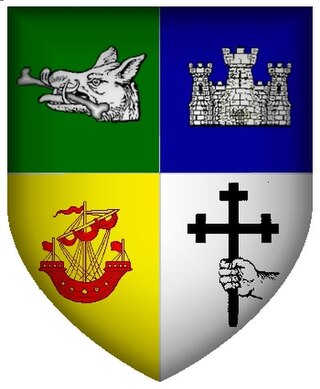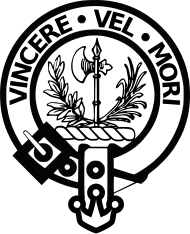
Duart Castle, or Caisteal Dhubhairt in Scottish Gaelic, is a castle on the Isle of Mull, beside the Sound of Mull off the west coast of Scotland, within the council area of Argyll and Bute. The castle dates back to the 13th century and is the seat of Clan MacLean. One source states that the castle was "brought back from ruin in 1911".

Clan Maclean is a Highlands Scottish clan. They are one of the oldest clans in the Highlands and owned large tracts of land in Argyll as well as the Inner Hebrides. Many early MacLeans became famous for their honour, strength and courage in battle. They were involved in clan skirmishes with the Mackinnons, Camerons, MacDonalds and Campbells, as well as all of the Jacobite risings.

Lochbuie is a settlement on the Isle of Mull in Scotland about 22 kilometres (14 mi) west of Craignure.

Clan MacKinnon is a Highland Scottish clan from the islands of Mull and Skye, in the Inner Hebrides.

MacLaine or Maclaine is a surname of Scottish origin. It may refer to:
Donald MacLean, 1st Laird of Brolas, was a Scottish Laird of Clan MacLean who fought in the battle of Battle of Inverkeithing. He was the first Laird of Brolas.

Sir Hector Og Maclean (1583–1623), or Eachann Óg Maclean in Scottish Gaelic, was the 15th Clan Chief of Clan Maclean in Scotland.
Hector Mor Maclean of Dowart, or Eachann Mór Maclean in Scottish Gaelic, or Hector the Great, was the 16th Clan Chief of Clan MacLean from 1623 to his death in 1626. Mór or Mor translates as great when added to a name in Scottish Gaelic. He resided at Duart Castle on the Isle of Mull. He was the first Chief of MacLean to not produce an heir in four hundred years, breaking the direct male line from Gillean of the Battle Axe, the founder of the clan to himself. He was succeeded by his younger brother, Lachlan Maclean, 1st Baronet.

Sir Lachlan Maclean, 1st Baronet of Morvern, the 17th Clan Chief of Clan Maclean. Lachlan was granted his Baronet title by Charles I and he became the Clan Chief on the death of his brother in 1626. He fought as a Royalist under James Graham, 1st Marquess of Montrose during the Wars of the Three Kingdoms at the Battle of Inverlochy, Battle of Auldearn and Battle of Kilsyth. From 1628 to 1633 he sat in the Parliament of Scotland as shire commissioner for Tarbert. From his rule onward, all Maclean clan chiefs are successive Baronets of Movern.

Colonel Sir Fitzroy Donald Maclean, 10th Baronet of Morvern, KCB, DL was a Scottish officer who served as the 26th Clan Chief of Clan Maclean from 1883 to 1936, for fifty-three years. He lived to be 101 years old. He bought and restored Duart Castle in 1911 as the seat of the Maclean clan.

Sir John Maclean, 4th Baronet of Duart and Morvern (1670–1716) was the 20th Clan Chief of Clan Maclean from 1674 to 1716. He was the 16th and last Laird of Duart, when in 1691 he lost Castle Duart to Archibald Campbell, 1st Duke of Argyll. The castle wasn't recovered by Clan Maclean until 1912 until it was purchased by Fitzroy Donald Maclean, 221 years later.
Gillean of the Battle Axe, or Gilleain na Tuaighe in Scottish Gaelic, was the eponymous ancestor of Clan Maclean and Clan Maclaine of Lochbuie. He is considered the 1st chief of Clan Maclean.
John Dubh Maclean, or Iain Dubh mac Gilliemore in Scottish Gaelic, or John Maclean the Black was the 4th Chief of Clan MacLean.
Lachlan Lùbanach Maclean, 5th Chief was Chief of Clan Maclean. He was the first Maclean to occupy Castle Duart as the 1st Laird of Duart. His brother, Hector Reaganach Maclean was the progenitor of the Lochbuie Macleans usually MacLaines.

Sir Lachlan Mór Maclean or Big Lachlan Maclean, was the 14th Clan Chief of Clan MacLean from late 1573 or early 1574 until 1598. Mór or Mor translates as big in English, or magnus in Latin, when added to a name in Scottish Gaelic.

Moy Castle is a ruined castle near Lochbuie on the Isle of Mull, Scotland. The site is now a scheduled monument.
William Cleireach MacLeod is considered to be 5th Chief of Clan MacLeod. He was a younger son of chief Iain Ciar and was originally intended to enter the church, as his nickname shows; however, on the death of his elder brother, William Cleireach became the heir to the chiefship. As chief of the clan, he led his followers in attacks against the Frasers and defended his lands against the MacDonalds. He did not live a long life and was said to have been buried on the isle of Iona with his predecessors.
The current chief of the Highland, Scottish clan, Clan Maclean is Sir Lachlan Hector Charles Maclean of Duart and Morvern Bt, CVO, Deputy Lord Lieutenant of Argyll and Bute, 28th clan chief and 12th Baronet of Morvern. The seat of the chiefs of Clan MacLean is Duart Castle on the Isle of Mull. Duart was given to Lachlan Lubanach Maclean as part of his wife's dowry.
Hector Odhar MacLean of Lochbuie, 9th Chief (1575–1628) was the 9th Chief of Clan Maclaine of Lochbuie.
Sir Lachlan Mackinnon was chief of the Scottish Highland clan Mackinnon and played a prominent part in the troubled and transitional politics of the West Highlands in the early 17th century.










